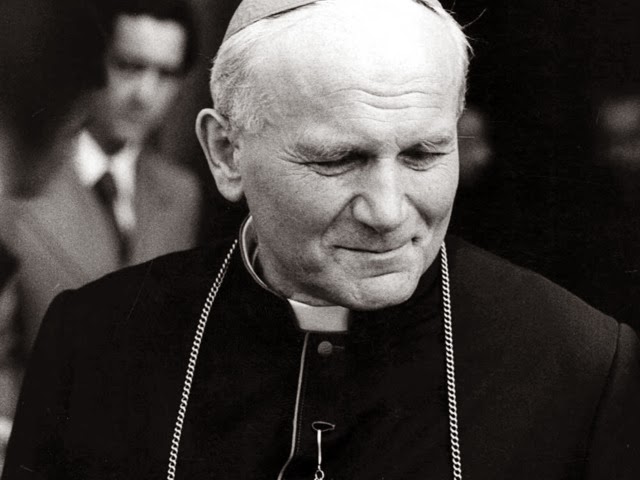Immediately after St. John Paul II’s death, priests, bishops and even the next pope, started to give the deceased pontiff the title of “John Paul the Great.” While there are no particular criteria written down as to why a saint is labeled “the Great,” there are three virtues he possessed which gave him an extraordinary ability to imitate the example and teaching of Jesus Christ.
[featured-image single_newwindow=”false”]
At first glance, however, these three virtues do not have any resemblance to “greatness” as the world would see it.
Pope Francis recently commented at a daily Mass homily that, “the style of the good God is not to produce a spectacle: God acts in humility, in silence, in the little things” (News.va). Later on in his homily he refined the point and added a second attribute to God’s mode of operation,
one of the three temptations of Jesus in the desert” was to create a spectacle. Satan invites Him to cast Himself down from the pinnacle of the Temple so that, seeing the miracle, the people might believe in Him. “The Lord, instead, is revealed in simplicity, in humility”…..“This is how the Lord acts: He does things simply. He speaks silently to you, to the heart. Let us remember in our lives the many time we have felt these things: the humility of God is His style; the simplicity of God is His style.” (News.va, emphasis added).
For John Paul II, while he did speak before large crowds like Jesus Christ, he always acted in humility and simplicity in the midst of all the attention. One tangible example of this is his visit to a rather unknown part of the US, in the middle of the state of Wisconsin.
In 1976, two years before he became pope, Cardinal Karol Wojtyła made an extra visit to a rural farm community in Wisconsin to give a lecture at the local university and to visit Polish farmers. In recounting the visit, a local priest confessed that Cardinal Wojtyła’s “most distinctive characteristics [were] ‘his simplicity; his humility; absolutely his humility. It is something that draws you to him.’” Even Bishop Freking, bishop of the Diocese of La Crosse at the time, saw these two primary attributes of the future Pope and added a third, saying, “He is first a holy man, a simple and humble man with a pleasant smile.”
So there you have it, humility, simplicity, holiness. Three virtues that make John Paul II worthy of the title “the Great,” because it is those attributes that most resemble the action of God in the world.
Let’s take a quick look at concrete examples of these three virtues in the life of John Paul “the Great.”
1. Humility
First of all, he possessed great humility. Throughout all his life, John Paul II did not “Lord” his power over others, but instead lead with the heart of a servant. At the very beginning of his priesthood he adopted the custom of Saint John Vianney of kissing the ground of the people he served. When he arrived at his small parish church in the foothills of the Carpathian Mountains, that is the first action he did when he arrived and he continued this custom throughout his papacy, especially while on his many papal visits. He was a servant leader and sought above all things to imitate Christ’s example at the Last Supper of washing the feet of his disciples.
One somewhat humorous example of his humility comes from his visit to Wisconsin. While eating breakfast with the Sisters of Saint Joseph in Stevens Point, Sister Carlene Blavat, SSJ-TOSF, remembers an impressive man who cleaned his plate when he was done. She recounts how he “wiped up every last bit of egg and bacon with his bread. His plate looked like it had been washed!” This action seems quite trivial, but the action of wiping ones plate is typically the duty of a servant. In a certain sense, some would think it is “beneath” an esteemed cardinal of the Church to wipe their plate clean.
2. Simplicity
Secondly, John Paul II was a very simple man. During his priestly service in Poland, John Paul II lead a simple life and did not take advantage of the many “benefits” there were to being a priest in a culture that viewed ordained clergy as royalty. One example of his simplicity was during one of his parish assignments. The “[n]uns at his church noticed that he wasn’t dressed warmly enough for the bitter Polish winter, so they knitted him a thick woolen sweater. Within a week, it was gone, because he had given it to the poor” (John Paul the Great: His Fives Loves, 50, emphasis added).
Another example occurred when he was teaching at the University of Lublin. Instead of accepting his salary, he instead gave it to students who couldn’t afford the tuition. Even his Polish housekeeper was a little frustrated by his simplicity, for she noted that “he refuses to wear new clothing; he always gives it away” (Ibid). Even his shoes were run ragged and he never bought a new pair until the ones he wore were completely impossible to wear.
While in Wisconsin a host of his offered him tea or coffee, and instead he simply asked for water. She was taken aback by his simplicity and was surprised to see such a high ranking cardinal prefer the simpler things in life.
3. Holiness
Last, but not least, John Paul II displayed great holiness throughout his entire life. One could always find him in his private chapel, usually laying prostrate before the altar. He prayed the Rosary and Stations of the Cross on a daily basis, even while traveling great distances on a plane. Most of all, he had an immense love of Jesus in the Holy Eucharist and had a interior magnet for finding a Eucharistic chapel to pray in.
He also recognized how much he needed spiritual support and always sought the assistance of the sick and elderly. While in Wisconsin, he visited two nursing homes, which was quite strange for a Polish cardinal to do while on a visit that lasted just over 24 hours. It was a custom he started as a bishop. After celebrating Mass at the chapel of the Daughters of Charity of St. Vincent de Paul in Kraków, Archbishop Wojtyła visited those in the infirmary where he said to the them,
“Although I am young and strong, although I fly in airplanes, climb mountains, ski, I still turn to the weakest, so that by the riches of their suffering they may bring down the strength and power of the Holy Spirit and the blessing of God upon my work in the Archdiocese.”[i]
As Pope Francis said, “The Lord is revealed in simplicity, in humility.” John Paul II powerfully exemplified those attributes of God and deserves the title “Great,” not because he was overly pompous, proud or powerful, but because he was humble, simple and holy.
Find these stories and more in my debut book In the Footsteps of a Saint: John Paul II’s Visit to Wisconsin. Available online through Amazon & WestBow Press. Order your copy today!
In the Footsteps of a Saint: John Paul II’s Visit to Wisconsin, is a vivid narrative of the historic days of August 23-24, 1976, but is also meant to be a testament to the shinning example of John Paul II’s sanctity. He touched and inspired people here by his profound humility, holiness and simplicity and his memory will never be forgotten.
[/callout]
[i] Boniecki, Adam. The Making Of The Pope Of The Millennium: Kalendarium of the Life of Karol Wojtyła. Stockbridge: Congregation of Marians of the Immaculate Conception, 2000, 234.


